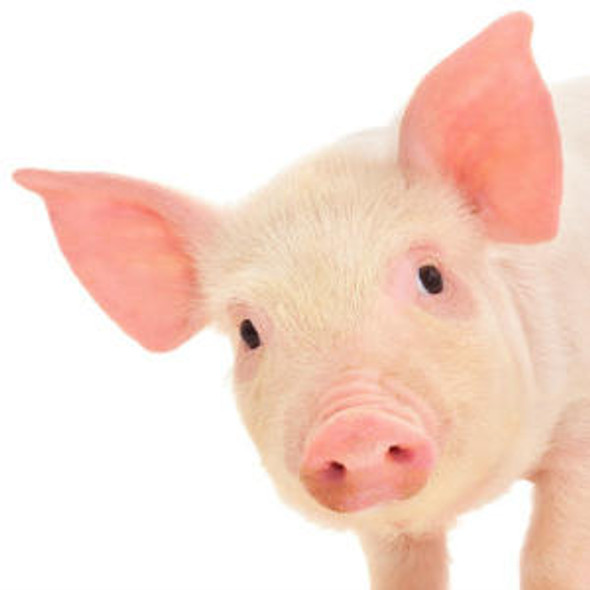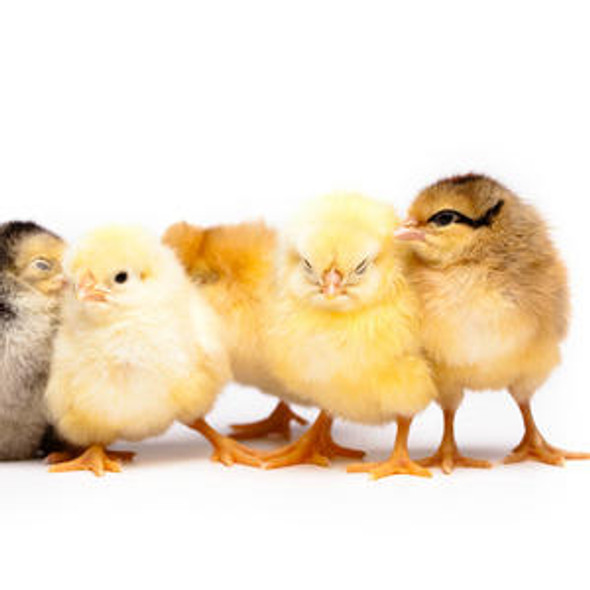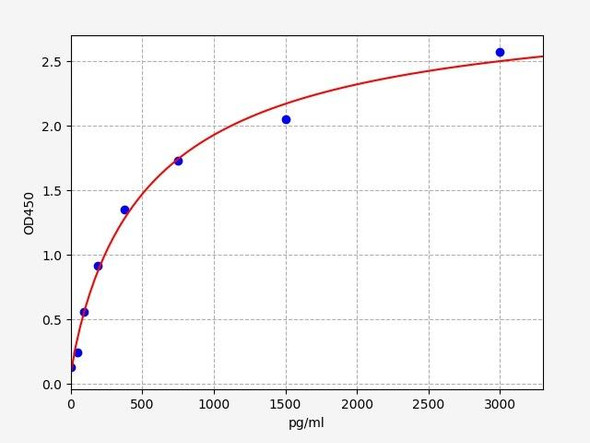Human Angiogenin / ANG ELISA Kit
- SKU:
- HUFI00032
- Product Type:
- ELISA Kit
- Size:
- 96 Assays
- Uniprot:
- P03950
- Sensitivity:
- 46.875pg/ml
- Range:
- 78.125-5000pg/ml
- ELISA Type:
- Sandwich ELISA, Double Antibody
- Synonyms:
- ANG, Angiogenin, ALS9, HEL168, RNASE4, RNASE5
- Reactivity:
- Human
Description
Human Angiogenin / ANG ELISA Kit
Angiogenin is a ribonuclease of the RNase A family. Angiogenin plays a role in cancer development. It functions as a tumor suppressor by inhibiting angiogenesis and tumor growth. Angiogenin can be used to create an artificial ribonuclease 5 enzymes which can be used to degrade the mRNA that encodes for angiogenin and thereby inhibit its own synthesis. The Assay Genie Human Angiogenin ELISA kit is a highly sensitive assay for the quantitative measurement of Angiogenin in serum, blood, plasma, cell culture supernatant, and tissue samples.
| Product Name: | Human Angiogenin / ANG ELISA Kit |
| Product Code: | HUFI00032 |
| Size: | 96 Assays |
| Alias: | ANG, Angiogenin, ALS9, HEL168, RNASE4, RNASE5 |
| Detection method: | Sandwich ELISA, Double Antibody |
| Application: | This immunoassay kit allows for the in vitro quantitative determination of Human ANG concentrations in serum plasma and other biological fluids. |
| Sensitivity: | 46.875pg/ml |
| Range: | 78.125-5000pg/ml |
| Storage: | 4°C for 6 months |
| Note: | For Research Use Only |
| Recovery: | Matrices listed below were spiked with certain level of Human ANG and the recovery rates were calculated by comparing the measured value to the expected amount of Human ANG in samples. | ||||||||||||||||
| |||||||||||||||||
| Linearity: | The linearity of the kit was assayed by testing samples spiked with appropriate concentration of Human ANG and their serial dilutions. The results were demonstrated by the percentage of calculated concentration to the expected. | ||||||||||||||||
| |||||||||||||||||
| CV(%): | Intra-Assay: CV<8% Inter-Assay: CV<10% |
| Component | Quantity | Storage |
| ELISA Microplate (Dismountable) | 8×12 strips | 4°C for 6 months |
| Lyophilized Standard | 2 | 4°C/-20°C |
| Sample/Standard Dilution Buffer | 20ml | 4°C |
| Biotin-labeled Antibody(Concentrated) | 120ul | 4°C (Protect from light) |
| Antibody Dilution Buffer | 10ml | 4°C |
| HRP-Streptavidin Conjugate(SABC) | 120ul | 4°C (Protect from light) |
| SABC Dilution Buffer | 10ml | 4°C |
| TMB Substrate | 10ml | 4°C (Protect from light) |
| Stop Solution | 10ml | 4°C |
| Wash Buffer(25X) | 30ml | 4°C |
| Plate Sealer | 5 | - |
Other materials and equipment required:
- Microplate reader with 450 nm wavelength filter
- Multichannel Pipette, Pipette, microcentrifuge tubes and disposable pipette tips
- Incubator
- Deionized or distilled water
- Absorbent paper
- Buffer resevoir
| Uniprot | P03950 |
| UniProt Protein Function: | ANG: May function as a tRNA-specific ribonuclease that abolishes protein synthesis by specifically hydrolyzing cellular tRNAs. Binds to actin on the surface of endothelial cells; once bound, angiogenin is endocytosed and translocated to the nucleus. Angiogenin induces vascularization of normal and malignant tissues. Angiogenic activity is regulated by interaction with RNH1 in vivo. Defects in ANG are the cause of susceptibility to amyotrophic lateral sclerosis type 9 (ALS9). ALS is a degenerative disorder of motor neurons in the cortex, brain stem and spinal cord. ALS is characterized by muscular weakness and atrophy. Belongs to the pancreatic ribonuclease family. |
| UniProt Protein Details: | Protein type:RNA-binding; Secreted, signal peptide; Ribonuclease; EC 3.1.27.-; Secreted; Motility/polarity/chemotaxis; Nucleolus; Extracellular matrix; Cell cycle regulation Chromosomal Location of Human Ortholog: 14q11.1-q11.2 Cellular Component: angiogenin-PRI complex; basal lamina; cell soma; cytoplasmic membrane-bound vesicle; extracellular region; extracellular space; growth cone; nucleolus; nucleus Molecular Function:actin binding; copper ion binding; DNA binding; endonuclease activity; heparin binding; peptide binding; protein binding; protein homodimerization activity; receptor binding; ribonuclease activity; rRNA binding Biological Process: actin filament polymerization; activation of phospholipase A2; activation of protein kinase B; angiogenesis; antibacterial humoral response; antifungal humoral response; cell communication; cell migration; defense response to Gram-positive bacterium; diacylglycerol biosynthetic process; homeostatic process; innate immune response; intercellular junction assembly and maintenance; negative regulation of smooth muscle cell proliferation; negative regulation of translation; oocyte maturation; ovarian follicle development; phospholipase C activation; placenta development; positive regulation of endothelial cell proliferation; positive regulation of phosphorylation; positive regulation of protein secretion; response to hormone stimulus; response to hypoxia; response to yeast; rRNA transcription Disease: Amyotrophic Lateral Sclerosis 9 |
| NCBI Summary: | The protein encoded by this gene is an exceedingly potent mediator of new blood vessel formation. It hydrolyzes cellular tRNAs resulting in decreased protein synthesis and is similar to pancreatic ribonuclease. In addition, the mature peptide has antimicrobial activity against some bacteria and fungi, including S. pneumoniae and C. albicans. Alternative splicing results in two transcript variants encoding the same protein. This gene and the gene that encodes ribonuclease, RNase A family, 4 share promoters and 5' exons. Each gene splices to a unique downstream exon that contains its complete coding region. [provided by RefSeq, Aug 2014] |
| UniProt Code: | P03950 |
| NCBI GenInfo Identifier: | 113873 |
| NCBI Gene ID: | 283 |
| NCBI Accession: | P03950.1 |
| UniProt Secondary Accession: | P03950,Q05CV1, Q53X86, Q6P5T2, Q8WXE7, |
| UniProt Related Accession: | P03950 |
| Molecular Weight: | 16,550 Da |
| NCBI Full Name: | Angiogenin |
| NCBI Synonym Full Names: | angiogenin, ribonuclease, RNase A family, 5 |
| NCBI Official Symbol: | ANG |
| NCBI Official Synonym Symbols: | ALS9; RAA1; HEL168; RNASE4; RNASE5 |
| NCBI Protein Information: | angiogenin |
| UniProt Protein Name: | Angiogenin |
| UniProt Synonym Protein Names: | Ribonuclease 5; RNase 5 |
| Protein Family: | Angiogenin |
| UniProt Gene Name: | ANG |
| UniProt Entry Name: | ANGI_HUMAN |
*Note: Protocols are specific to each batch/lot. For the correct instructions please follow the protocol included in your kit.
Before adding to wells, equilibrate the SABC working solution and TMB substrate for at least 30 min at 37°C. When diluting samples and reagents, they must be mixed completely and evenly. It is recommended to plot a standard curve for each test.
| Step | Protocol |
| 1. | Set standard, test sample and control (zero) wells on the pre-coated plate respectively, and then, record their positions. It is recommended to measure each standard and sample in duplicate. Wash plate 2 times before adding standard, sample and control (zero) wells! |
| 2. | Aliquot 0.1ml standard solutions into the standard wells. |
| 3. | Add 0.1 ml of Sample / Standard dilution buffer into the control (zero) well. |
| 4. | Add 0.1 ml of properly diluted sample ( Human serum, plasma, tissue homogenates and other biological fluids.) into test sample wells. |
| 5. | Seal the plate with a cover and incubate at 37 °C for 90 min. |
| 6. | Remove the cover and discard the plate content, clap the plate on the absorbent filter papers or other absorbent material. Do NOT let the wells completely dry at any time. Wash plate X2. |
| 7. | Add 0.1 ml of Biotin- detection antibody working solution into the above wells (standard, test sample & zero wells). Add the solution at the bottom of each well without touching the side wall. |
| 8. | Seal the plate with a cover and incubate at 37°C for 60 min. |
| 9. | Remove the cover, and wash plate 3 times with Wash buffer. Let wash buffer rest in wells for 1 min between each wash. |
| 10. | Add 0.1 ml of SABC working solution into each well, cover the plate and incubate at 37°C for 30 min. |
| 11. | Remove the cover and wash plate 5 times with Wash buffer, and each time let the wash buffer stay in the wells for 1-2 min. |
| 12. | Add 90 µl of TMB substrate into each well, cover the plate and incubate at 37°C in dark within 10-20 min. (Note: This incubation time is for reference use only, the optimal time should be determined by end user.) And the shades of blue can be seen in the first 3-4 wells (with most concentrated standard solutions), the other wells show no obvious color. |
| 13. | Add 50 µl of Stop solution into each well and mix thoroughly. The color changes into yellow immediately. |
| 14. | Read the O.D. absorbance at 450 nm in a microplate reader immediately after adding the stop solution. |
When carrying out an ELISA assay it is important to prepare your samples in order to achieve the best possible results. Below we have a list of procedures for the preparation of samples for different sample types.
| Sample Type | Protocol |
| Serum | If using serum separator tubes, allow samples to clot for 30 minutes at room temperature. Centrifuge for 10 minutes at 1,000x g. Collect the serum fraction and assay promptly or aliquot and store the samples at -80°C. Avoid multiple freeze-thaw cycles. If serum separator tubes are not being used, allow samples to clot overnight at 2-8°C. Centrifuge for 10 minutes at 1,000x g. Remove serum and assay promptly or aliquot and store the samples at -80°C. Avoid multiple freeze-thaw cycles. |
| Plasma | Collect plasma using EDTA or heparin as an anticoagulant. Centrifuge samples at 4°C for 15 mins at 1000 × g within 30 mins of collection. Collect the plasma fraction and assay promptly or aliquot and store the samples at -80°C. Avoid multiple freeze-thaw cycles. Note: Over haemolysed samples are not suitable for use with this kit. |
| Urine & Cerebrospinal Fluid | Collect the urine (mid-stream) in a sterile container, centrifuge for 20 mins at 2000-3000 rpm. Remove supernatant and assay immediately. If any precipitation is detected, repeat the centrifugation step. A similar protocol can be used for cerebrospinal fluid. |
| Cell culture supernatant | Collect the cell culture media by pipette, followed by centrifugation at 4°C for 20 mins at 1500 rpm. Collect the clear supernatant and assay immediately. |
| Cell lysates | Solubilize cells in lysis buffer and allow to sit on ice for 30 minutes. Centrifuge tubes at 14,000 x g for 5 minutes to remove insoluble material. Aliquot the supernatant into a new tube and discard the remaining whole cell extract. Quantify total protein concentration using a total protein assay. Assay immediately or aliquot and store at ≤ -20 °C. |
| Tissue homogenates | The preparation of tissue homogenates will vary depending upon tissue type. Rinse tissue with 1X PBS to remove excess blood & homogenize in 20ml of 1X PBS (including protease inhibitors) and store overnight at ≤ -20°C. Two freeze-thaw cycles are required to break the cell membranes. To further disrupt the cell membranes you can sonicate the samples. Centrifuge homogenates for 5 mins at 5000xg. Remove the supernatant and assay immediately or aliquot and store at -20°C or -80°C. |
| Tissue lysates | Rinse tissue with PBS, cut into 1-2 mm pieces, and homogenize with a tissue homogenizer in PBS. Add an equal volume of RIPA buffer containing protease inhibitors and lyse tissues at room temperature for 30 minutes with gentle agitation. Centrifuge to remove debris. Quantify total protein concentration using a total protein assay. Assay immediately or aliquot and store at ≤ -20 °C. |
| Breast Milk | Collect milk samples and centrifuge at 10,000 x g for 60 min at 4°C. Aliquot the supernatant and assay. For long term use, store samples at -80°C. Minimize freeze/thaw cycles. |










